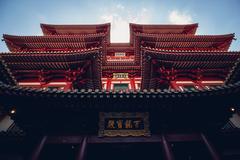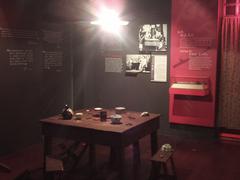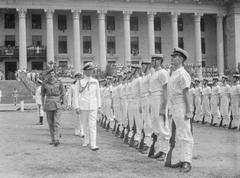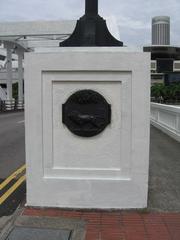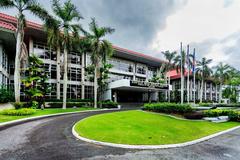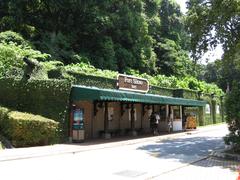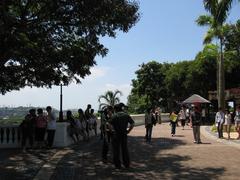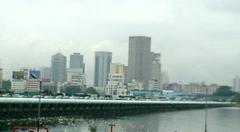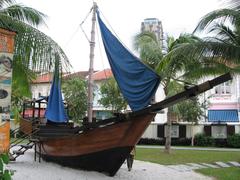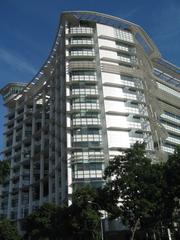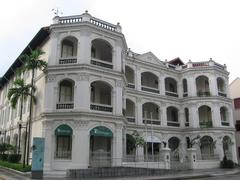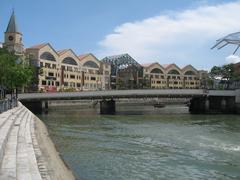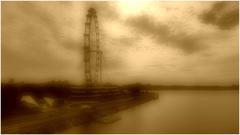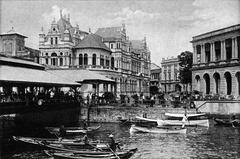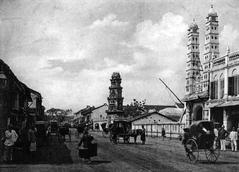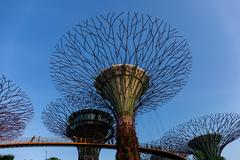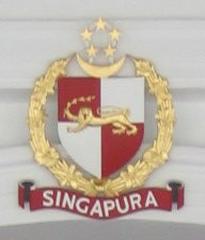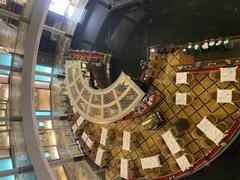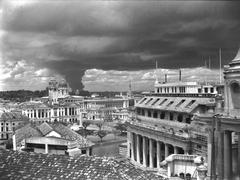Visiting Hours, Tickets, and Historical Significance of Fort Canning Gate, Singapore
Date: 23/07/2024
Introduction
Fort Canning Gate, located in the heart of Singapore, is a historical landmark that offers a glimpse into the rich cultural and military past of the city-state. Originally known as Bukit Larangan or ‘Forbidden Hill,’ this site has been of strategic importance for centuries, dating back to ancient Malay royalty. The fort itself was constructed in 1859 by the British colonial government to protect Singapore from potential sea attacks. Over the years, Fort Canning has played various roles, from a military installation during the British colonial era to a headquarters during World War II and the Japanese occupation (National Heritage Board, Roots.gov.sg).
Today, Fort Canning Gate stands as a testament to Singapore’s multifaceted history, featuring neoclassical architectural elements and the coat of arms of the British East India Company. The gate is part of the larger Fort Canning Park, a serene environment offering historical trails, gardens, and museums for visitors to explore. The park is easily accessible and provides a range of attractions and activities, making it a must-visit for history enthusiasts and tourists alike (Visit Singapore).
This comprehensive guide aims to provide all the essential information you need for an enriching visit to Fort Canning Gate, including its historical significance, architectural features, visiting hours, ticket information, and practical tips to make the most of your experience.
Table of Contents
- [Fort Canning Gate - History, Visiting Hours, and Tickets](#fort-canning-gate---history-visiting-hours-and-ticketsfort-canning-gate---history-visiting-hours-and-tickets)
- [Early History and Construction](#early-history-and-constructionearly-history-and-construction)
- [British Colonial Era](#british-colonial-erabritish-colonial-era)
- [World War II and Japanese Occupation](#world-war-ii-and-japanese-occupationworld-war-ii-and-japanese-occupation)
- [Post-War Period and Restoration](#post-war-period-and-restorationpost-war-period-and-restoration)
- [Architectural Features](#architectural-featuresarchitectural-features)
- [Cultural Significance](#cultural-significancecultural-significance)
- [Visitor Experience](#visitor-experiencevisitor-experience)
- [Visiting Hours and Tickets](#visiting-hours-and-ticketsvisiting-hours-and-tickets)
- [Preservation Efforts](#preservation-effortspreservation-efforts)
- [FAQ](#faqfaq)
- [Visitor Tips](#visitor-tipsvisitor-tips)
- [Best Time to Visit](#best-time-to-visitbest-time-to-visit)
- [Getting There](#getting-theregetting-there)
- [Guided Tours](#guided-toursguided-tours)
- [Accessibility](#accessibilityaccessibility)
- [Nearby Attractions](#nearby-attractionsnearby-attractions)
- [Safety Tips](#safety-tipssafety-tips)
- [Photography Tips](#photography-tipsphotography-tips)
- [Cultural Etiquette](#cultural-etiquettecultural-etiquette)
- [Refreshments and Facilities](#refreshments-and-facilitiesrefreshments-and-facilities)
- [Special Events](#special-eventsspecial-events)
- [Conclusion](#conclusionconclusion)
- [References](#referencesreferences)
Fort Canning Gate - History, Visiting Hours, and Tickets
Early History and Construction
Fort Canning Gate, located in the heart of Singapore, is a significant historical landmark that dates back to the early 19th century. The gate is part of Fort Canning Hill, which has been a site of strategic importance for centuries. The hill was originally known as Bukit Larangan, or “Forbidden Hill,” and was believed to be the seat of ancient Malay royalty. The fort itself was constructed in 1859 by the British colonial government to protect Singapore from potential sea attacks (National Heritage Board).
British Colonial Era
During the British colonial era, Fort Canning served as a key military installation. The fort was equipped with barracks, a hospital, and various military facilities. The gate, which is one of the most prominent features of the fort, was built as the main entrance to the military complex. It was designed in a neoclassical style, reflecting the architectural preferences of the British at the time. The gate’s construction was part of a broader effort to fortify Singapore, which was a crucial trading post in the British Empire (Roots.gov.sg).
World War II and Japanese Occupation
Fort Canning played a pivotal role during World War II. In February 1942, the British used the fort as their headquarters during the Battle of Singapore. Despite their efforts, Singapore fell to the Japanese, and Fort Canning was subsequently occupied by Japanese forces. The gate and the fort were used by the Japanese as a military command center. This period marked a dark chapter in the history of Fort Canning, as it became a symbol of the Japanese occupation of Singapore (Singapore Infopedia).
Post-War Period and Restoration
After World War II, Fort Canning was returned to British control and continued to serve as a military installation until Singapore’s independence in 1965. Following independence, the fort and its gate fell into disrepair. However, recognizing its historical significance, the Singapore government initiated restoration efforts in the late 20th century. The gate was meticulously restored to its former glory, preserving its architectural integrity while making it accessible to the public (National Parks Board).
Architectural Features
Fort Canning Gate is an excellent example of neoclassical architecture. It features a grand archway flanked by two imposing columns, which are adorned with intricate carvings. The gate’s design reflects the British colonial aesthetic, characterized by symmetry, proportion, and the use of classical elements. The gate also bears the coat of arms of the British East India Company, symbolizing its historical connection to British colonial rule (Roots.gov.sg).
Cultural Significance
Fort Canning Gate is not just a historical monument; it is also a cultural symbol. It represents the various phases of Singapore’s history, from its ancient Malay roots to its colonial past and its journey to independence. The gate is a reminder of the strategic importance of Fort Canning Hill and its role in shaping the history of Singapore. Today, it stands as a testament to the resilience and adaptability of the city-state (National Heritage Board).
Visitor Experience
Visitors to Fort Canning Gate can explore the rich history and architectural beauty of the site. The gate is part of the larger Fort Canning Park, which offers a range of attractions, including historical trails, gardens, and museums. Information panels and guided tours provide insights into the history of the gate and the fort, making it a must-visit for history enthusiasts. The park is easily accessible and offers a serene environment for visitors to reflect on the historical significance of the site (Visit Singapore).
Visiting Hours and Tickets
Fort Canning Gate and Fort Canning Park are open daily from 7:00 AM to 11:00 PM. There is no entrance fee to visit the park or the gate. However, certain attractions within the park, such as guided tours or special exhibitions, may have separate ticket prices. It is advisable to check the official website for the most up-to-date information on tickets and visiting hours.
Preservation Efforts
The preservation of Fort Canning Gate is an ongoing effort. The Singapore government, along with various heritage organizations, continues to invest in the maintenance and restoration of the gate and the surrounding fort. These efforts ensure that future generations can appreciate the historical and cultural significance of this iconic landmark. The gate is also part of educational programs aimed at raising awareness about Singapore’s rich history (National Parks Board).
FAQ
Q: What are the visiting hours for Fort Canning Gate?
- A: Fort Canning Gate is open daily from 7:00 AM to 11:00 PM.
Q: Is there an entrance fee to visit Fort Canning Gate?
- A: No, there is no entrance fee to visit Fort Canning Gate. However, certain attractions within the park may have separate ticket prices.
Q: Are guided tours available?
- A: Yes, guided tours are available and can provide in-depth insights into the history of the site.
Q: What are some nearby attractions?
- A: Nearby attractions include the National Museum of Singapore, Clarke Quay, and the Singapore River.
Q: Is Fort Canning Gate accessible for people with disabilities?
- A: Yes, the park has facilities to accommodate visitors with disabilities.
Visitor Tips
Best Time to Visit
The best time to visit Fort Canning Gate is during the cooler months from November to February. The weather is more pleasant, making it easier to explore the surrounding Fort Canning Park. Early mornings and late afternoons are ideal times to visit to avoid the midday heat.
Getting There
Fort Canning Gate is centrally located in Singapore, making it easily accessible by various modes of transportation. The nearest MRT station is Fort Canning Station on the Downtown Line. From there, it is a short walk to the gate. The site is also wheelchair accessible, with ramps and pathways designed to accommodate visitors with mobility issues.
Guided Tours
For a more in-depth understanding of the site’s history, consider joining a guided tour. Several tour operators offer historical tours that include Fort Canning Gate as part of a broader exploration of Fort Canning Hill. These tours often provide valuable insights and anecdotes that are not available through self-guided visits.
Accessibility
Fort Canning Gate is easily accessible via public transportation. The nearest MRT station is Fort Canning Station on the Downtown Line. From there, it is a short walk to the gate. The site is also wheelchair accessible, with ramps and pathways designed to accommodate visitors with mobility issues.
Nearby Attractions
While visiting Fort Canning Gate, take the opportunity to explore other attractions within Fort Canning Park. These include the Battlebox, an underground command center used during World War II, and the Spice Garden, which showcases a variety of tropical plants and spices. The park also features several walking trails, offering a peaceful retreat from the bustling city.
Safety Tips
- Stay on Marked Paths: To preserve the park’s natural environment and for your safety, always stay on marked paths.
- Weather Precautions: Check the weather forecast before your visit. In case of thunderstorms, seek shelter immediately.
- Wildlife: While encounters with wildlife are rare, it’s best to observe any animals from a distance and not feed them.
Photography Tips
Fort Canning Gate is a popular spot for photography enthusiasts. To capture the best shots, visit during the golden hours of sunrise or sunset when the lighting is soft and flattering. The gate’s intricate details and historical ambiance make it an excellent subject for both amateur and professional photographers.
For a unique perspective, try photographing the gate from different angles and distances. The surrounding greenery of Fort Canning Park provides a natural frame that enhances the composition of your photos.
Cultural Etiquette
While Fort Canning Gate is a historical site, it is also a place of cultural significance. Here are some etiquette tips to keep in mind:
- Respect the Site: Avoid touching or climbing on the gate and other historical structures.
- Quiet Reflection: The park is a place for both recreation and reflection. Keep noise levels down, especially near historical markers and memorials.
- Littering: Singapore has strict laws against littering. Use the designated bins to dispose of any trash.
Refreshments and Facilities
There are several cafes and restaurants within and around Fort Canning Park where you can take a break and enjoy a meal or a drink. The park also has restroom facilities, including accessible toilets. For a more leisurely experience, consider bringing a picnic to enjoy in one of the park’s many scenic spots.
Special Events
Fort Canning Park often hosts special events, such as outdoor concerts, festivals, and historical reenactments. Check the NParks events calendar to see if any events coincide with your visit. Participating in these events can provide a unique and enriching experience.
Conclusion
Fort Canning Gate is more than just a historical monument; it is a symbol of Singapore’s rich and diverse heritage. From its early days as a royal seat to its role in colonial defense and wartime strategy, the gate has witnessed significant historical events that have shaped the city’s identity. Today, it stands as a cultural and historical landmark, offering visitors a unique opportunity to delve into Singapore’s past while enjoying the natural beauty of Fort Canning Park. Efforts by the Singapore government and various heritage organizations ensure that this iconic landmark is preserved for future generations to appreciate (National Parks Board).
Whether you are a history buff, a cultural enthusiast, or simply looking for a scenic spot to explore, Fort Canning Gate offers a memorable experience that connects the past with the present. With no entrance fee and a range of attractions nearby, it is an accessible and enriching destination for both locals and tourists. For a more detailed and interactive experience, consider joining a guided tour or participating in one of the special events hosted at Fort Canning Park. Don’t forget to check the official website for the latest updates on visiting hours, tickets, and events. Happy exploring!
References
- National Heritage Board, 2023, https://www.nhb.gov.sg
- Roots.gov.sg, 2023, https://www.roots.gov.sg
- Singapore Infopedia, 2016, https://eresources.nlb.gov.sg/infopedia/articles/SIP_2016-07-04_090000.html
- National Parks Board, 2023, https://www.nparks.gov.sg
- Visit Singapore, 2023, https://www.visitsingapore.com



